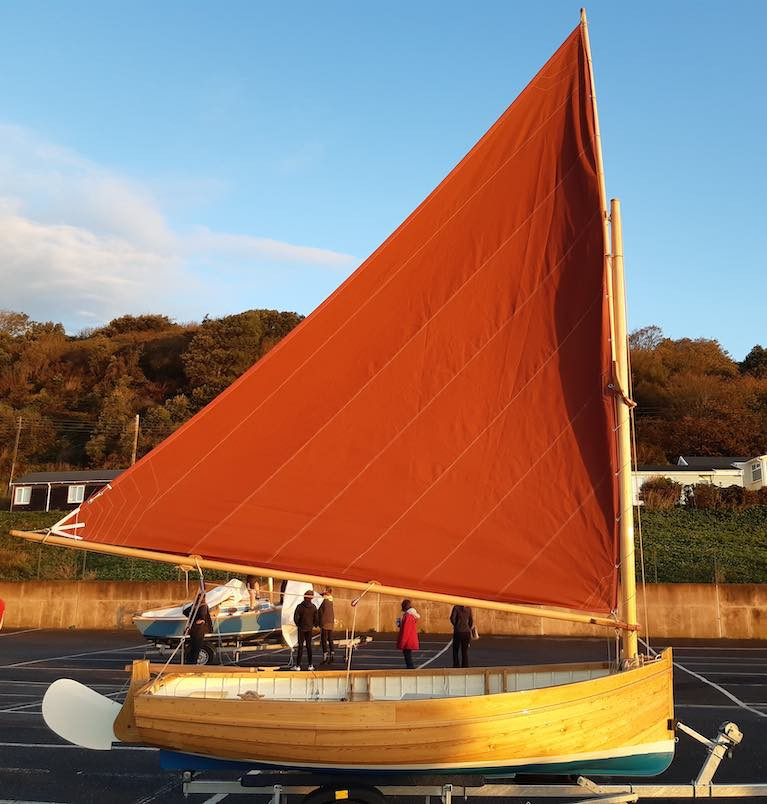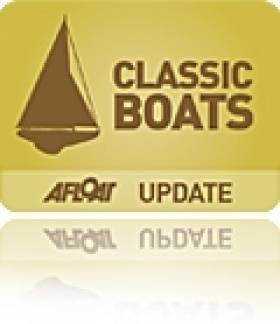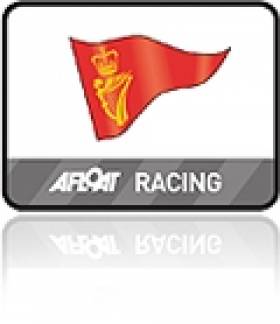Displaying items by tag: clinker
Ireland’s Clinker-Built Boats Lead The Way In New UNESCO Heritage Status
Now hear this, all you sailors or rowers of Greencastle Yawls, Dublin Bay Water Wags, Foyle Punts, International 12s, Shannon One Designs, Castlehaven Ettes, Strangford Lough Clippers, Coastal Hobbler Rowing Skiffs, Dublin Bay Mermaids, Mayfly-Fishing Lakeboats, IDRA 14s, Ballyholme Insects, Classic Ramelton Folkboats and any other boats constructed in what our American cousins would more elegantly describe as the lapstrake method, but we know rather prosaically as clinker-built.
That may sound to the totally uninitiated as something you’d put together from the leftovers in the ashtray of that old heroically-polluting kitchen coke stove upon which the Granny was accustomed to burn the Christmas sprouts long before charred vegetables became – for some inscrutable reason – a favoured item of gourmet dining.
Thus the alternative “clench-built” may be a more accurately descriptive if less-used term to describe this boat-building technique. But either way, the news is that those of you who go afloat in craft built in this way are no longer just going for a race or a sail or a bit of leisurely rowing. On the contrary, you will be engaged in Curating an Item of World Heritage.
This is serious stuff, and Ireland is very much involved in it both through our Dublin Viking boat-building links, and through the Greencastle yawls of the north coast, which were based in the “Drontheim Boats” which were built in Trondheim in Norway – it was the furthest-north Norwegian port with ready access to forest timber - and exported to many northwest Europe ports.
 The classic McDonald-built Greencastle Yawl James Kelly, owned by Robin Ruddock of Portrush and seen here sailing under sloop rig on Belfast Lough. She is named in honour of the renowned Portrush boatbuilder James Kelly, who built many traditional clinker yawls in addition to yachts for the Howth 17 and Dublin Bay 21 classes. Photo: W M Nixon
The classic McDonald-built Greencastle Yawl James Kelly, owned by Robin Ruddock of Portrush and seen here sailing under sloop rig on Belfast Lough. She is named in honour of the renowned Portrush boatbuilder James Kelly, who built many traditional clinker yawls in addition to yachts for the Howth 17 and Dublin Bay 21 classes. Photo: W M Nixon
According to the Press Release from our friends in the Viking Ship Museum of Roskilde in Denmark who led the UNESCO campaign, the official story is that:
“The clinker-built boats of the North – and the traditions associated with them – have now been officially acknowledged by UNESCO as living cultural heritage, which must be safeguarded and preserved for future generations”
So far, so good. But if we go further into the Danish release, that all-embracing term “clinker-built boats of the north” very quickly becomes slightly but significantly re-shaped as “Nordic clinker boats”. It’s true enough up to a point. But the reason we’re so familiar with the Viking Ship Museum at Roskilde is because it was they who achieved the re-creation of one of the largest clinker-built boats ever built, the 100ft Viking ship Sea Stallion, which voyaged from Scandinavia for a year-long visit to Dublin in 2007, and picked up awards for our “Sailors of the Month” while they were at it, but that’s another story.
The fact is the original Sea Stallion was actually built in Dublin around 1042, using timber sourced in Glendalough in County Wicklow, which suggests a very real Irish input. Since then, the clinker-built inheritance has been maintained on our north and northwest coasts, where it goes about as far south as Milk Harbour in County Sligo on the West Coast. Meanwhile, on the East and South Coasts, it continued as the preferred method of construction for smaller fishing craft and – in due course – for leisure dinghies and small yachts.
 Back where she belongs……the 30 metre Viking ship Sea Stallion on display in Collins Barracks in Dubin in 2007.
Back where she belongs……the 30 metre Viking ship Sea Stallion on display in Collins Barracks in Dubin in 2007.
You only have to look at the beautifully-traditional clinker construction of craft like the McDonald of Greencastle-built yawl James Kelly of Portrush, or a Jimmy Furey of Lough Ree-built Shannon One Design, or a West Cork-built Rui Ferreira of Ballydehob Water Wag, to realise that today, some of the best classic clinker-built construction is happening in Ireland.
We may not have invented clinker boat-building, for no one would argue other than that the classic Viking ship is one of mankind’s most remarkable creations. But we can reasonably claim that in awarding global Heritage Recognition to clinker construction, UNESCO is simply catching up with a state of affairs that has existed in Ireland for very many years. Welcome aboard.
Howth RNLI to Benefit from Dublin Bay Old Gaffers Zoom Session On Building Bray Droleen Dinghy
The Dublin Bay Old Gaffers Association winter talks series on Zoom continues on Thursday (November 26th) with a deeper insight into a classic boat-building story that has featured recently on Afloat.ie
DBOGA member and a graduate of the Boat Building Academy in Dorset, Michael Weed from Donegal, will talk about the Droleen (Dreoilín), a one-class design dinghy built in the late 1890s for members of Bray Sailing Club. The designer was club member W Ogilvy, and the original builder was Foley of Ringsend.
The Droleen class was described by Henry Coleman Folkard in his international nautical bible "The Sailing Boat" of 1906 as being of "so safe and sturdy a form that they can carry their whole sail, without reefing, in almost any weather that an open boat can be out in".
Michael's talk will cover not just the origins and history of the class, but also the construction of the Droleen which he recently undertook with his colleagues at the Boat Building Academy.
DBOGA Fundraising for Howth RNLI: Pre-Covid, DBOGA listened to talks together at Poolbeg Y&BC in Ringsend while passing the Yellow Welly around for €5 donation for the RNLI Howth Branch, to which the Association recently paid €1500 from activities in 2019/2020. In Zoom Land, the DBOGA has to hand round the Yellow Welly Online, and the RNLI urgently needs funds.
Please click on www.justgiving.com/fundraising/DBOGAHowthLifeboat to donate your €5. Thank you.
The details of this Zoom meeting are:
Topic: Michael Weed Droleen Talk
Time: Thursday Nov 26, 2020 20:00
Link to join meeting: https://us02web.zoom.us/j/84992586133
Meeting ID: 849 9258 6133
When a yacht is one hundred years old, it might be normal to celebrate the event, perhaps by breaking open a bottle of champagne with a few close friends, or having a small celebratory article printed in ‘Afloat.ie’, or even head off on a remarkable cruise, to celebrate such a long survival.
However, the Shannon one-design class, designed by Francis Charles Morgan-Giles (1883-1964) built their preview boat in 1921 (which no longer survives), and trials were offered to sailors on the Shannon River, in order to promote the idea of a one-design for the Shannon. Everybody who sailed the new boat were impressed, and during the winter and spring of 1922, nine boats were built to the new design, seven of which were built by Walter Levinge of Creaghduff, Athlone, Co. Westmeath. Numbering started at No. 32, so these new boats were Nos. 33, 34, 35, 36, 37, 38 and 40.
In 2017, the surviving boats, Nos. 32, 33, 37 and 40, celebrated their 95th birthday, so, it was decided to have a pre-regatta, in preparation for a bumper centenary regatta in 2022. It was the owners of No. 37, ‘Kiwi’, Peter and Owen Delany and their siblings, who put together the idea of the pre-centenary regatta to be held at Lough Ree Yacht Club (Est. 1770) over the weekend of 29-30 July. A notice was circulated to the owners of the other 95 year olds, and to all the newer Shannon one-design owners (most recent boat in No. 179), and 15 boats turned up to race and to party.
On Saturday, the wind was 12-25 knots which resulted in one compulsory reef. Race one went to the opportunistic Alan and DJ Algeo in No. 138. Then, after lunch, race two was won by Andrew Mannion in No. 97, who also managed to win race three. This was followed by a Pimms party, and dinner for eighty celebrants in the Lough Ree clubhouse.
On Sunday, the rain belted down, but the wind was lighter, so the reef was no longer mandatory. Racing north of the Yellow Islands, saw Miss Georgina Corbett in No. 108 win race four, and race five was won by veteran sailor Frank Browne in No. 86. The final race after lunch was held in the flukey waters close to the clubhouse, and was won by Harmon Murtagh Snr and Jnr. as popular winners.
However, there were no discards in the six race series, which resulted in Miss. Corbett being declared the overall winner by one point from Dr. Mark McCormack on No. 50 which was built in 1925. For full results see below, and all SOD sailors are welcome back in 2022.
Wooden Boat Building In Fermanagh: Keeping The History Alive
#HistoricBoats - The storied tradition of wooden boat building in Fermanagh is the subject of a new exhibition at Enniskillen Library from next Monday 29 June to Saturday 4 July.
Photos, anecdotes and artefacts of the era of clinker-built boats and cots before the advent of fibreglass will be on display at the library each day between 10am and 4pm.
And organisers with Lough Erne Heritage are also looking to gather information from local people, many of whom still have valuable old-school boatbuilding knowledge, that could tell us even more about those bygone days.
Stories, photographs, cine film and images of original boats and related artefacts such as hand tools and early outboard engines - if you have them, bring them along for recording in the collection.
National 18s Aim for Big Turn-Out
The club hopes over 50 boats will participate across three separate divisions:-
Ultimates - The modern fibreglass boats of the racing fleet.
Penultimates - The older fiberglass boats that have been hiding in garages waiting to be taken out for the 2011 championship.
Classics - The beautiful wooden clinker-built boats that have re-surfaced in Crosshaven, West Cork and further afield in recent years.
More on this class by Tom MacSweeney HERE

































































